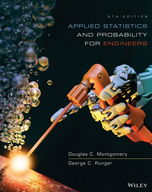Solution Found!
Consider the following computer output. (a) Fill in the
Chapter 10, Problem 14E(choose chapter or problem)
Consider the following computer output.
Two-Sample T-Test and C1
\(\begin{array}{lllll}
\text { Sample } & \mathrm{N} & \text { Mean } & \text { StDev } & \text { SE Mean } \\
1 & 12 & 10.94 & 1.26 & 0.36 \\
2 & 16 & 12.15 & 1.99 & 0.5
\end{array}\)
Difference = \(mu\left( 1 \right)=mu\left( 2 \right) \)
Estimate for difference: -1.210
95% CI for difference: \(\left( -2.560,0.140 \right) \)
T-test of difference =0 (vs not =) :
T-value = ? p-value = ? DF = ?
Both use Pooled StDev = ?
(a) Fill in the missing values. Is this a one-sided or a two-sided test? Use lower and upper bounds for the p -value.
(b) What are your conclusions if \(\alpha =0.05\)? What if \( \alpha =0.01\)?
(c) This test was done assuming that the two population variances were equal. Does this seem reasonable?
(d) Suppose that the hypothesis had been \({{H}_{0}}:{{\mu }_{1}}={{\mu }_{2}}\) versus \({{H}_{0}}:{{\mu }_{1}}<{{\mu }_{2}}\). What would your conclusions be if \(\alpha =0.05\)?
Questions & Answers
QUESTION:
Consider the following computer output.
Two-Sample T-Test and C1
\(\begin{array}{lllll}
\text { Sample } & \mathrm{N} & \text { Mean } & \text { StDev } & \text { SE Mean } \\
1 & 12 & 10.94 & 1.26 & 0.36 \\
2 & 16 & 12.15 & 1.99 & 0.5
\end{array}\)
Difference = \(mu\left( 1 \right)=mu\left( 2 \right) \)
Estimate for difference: -1.210
95% CI for difference: \(\left( -2.560,0.140 \right) \)
T-test of difference =0 (vs not =) :
T-value = ? p-value = ? DF = ?
Both use Pooled StDev = ?
(a) Fill in the missing values. Is this a one-sided or a two-sided test? Use lower and upper bounds for the p -value.
(b) What are your conclusions if \(\alpha =0.05\)? What if \( \alpha =0.01\)?
(c) This test was done assuming that the two population variances were equal. Does this seem reasonable?
(d) Suppose that the hypothesis had been \({{H}_{0}}:{{\mu }_{1}}={{\mu }_{2}}\) versus \({{H}_{0}}:{{\mu }_{1}}<{{\mu }_{2}}\). What would your conclusions be if \(\alpha =0.05\)?
ANSWER:Step 1 of 4
(a) The missing values can be calculated using the information provided.
Two sample t-test for equal variances:
\({{H}_{0}}:{{\mu }_{1}}-{{\mu }_{2}}=0 \\ \)
\({{H}_{A}}:{{\mu }_{1}}-{{\mu }_{2}}\ne 0 \)
The Pooled standard deviation is:
\({{S}_{p}}=\sqrt{\dfrac{\left( {{n}_{1}}-1 \right){{S}_{1}}^{2}+\left( {{n}_{2}}-1 \right){{S}_{2}}^{2}}{{{n}_{1}}+{{n}_{2}}-2}} \\ \)
\(=\sqrt{\dfrac{12\times \left( {{1.26}^{2}} \right)+16\times \left( {{1.99}^{2}} \right)}{12+16-2}} \\ \)
\( =1.7194 \)
The T-value can be calculated as the difference estimate divided by the standard error of the difference:
\(t=\dfrac{{{{\bar{x}}}_{1}}-{{{\bar{x}}}_{2}}}{{{S}_{P}}\sqrt{\left( \dfrac{1}{{{n}_{1}}}+\dfrac{1}{{{n}_{2}}} \right)}} \\ \)
\(=\dfrac{10.94-12.15}{1.7194\sqrt{\left( \dfrac{1}{12}+\dfrac{1}{16} \right)}} \\ \)
\( =-1.8427 \)
Degree of freedom is:
\( df={{n}_{1}}+{{n}_{2}}-2 \\ \)
\(=12+16-2 \\ \)
\( =26 \)
To find the p-value, you would need to consult a t-distribution table or use statistical software. The p-value represents the probability of observing a T-value as extreme as or more extreme than the calculated T-value, assuming the null hypothesis is true. The p-value is 0.0768 and is lies between 0.1 and 0.05. It is a Two-tailed test.
